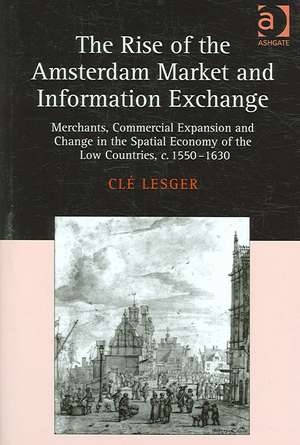The Rise of the Amsterdam Market and Information Exchange: Merchants, Commercial Expansion and Change in the Spatial Economy of the Low Countries, c.1550–1630
Autor Clé Lesgeren Limba Engleză Hardback – 10 aug 2006
Preț: 826.15 lei
Preț vechi: 1144.13 lei
-28% Nou
Puncte Express: 1239
Preț estimativ în valută:
158.08€ • 165.06$ • 130.54£
158.08€ • 165.06$ • 130.54£
Carte tipărită la comandă
Livrare economică 15-29 aprilie
Preluare comenzi: 021 569.72.76
Specificații
ISBN-13: 9780754652205
ISBN-10: 0754652203
Pagini: 344
Dimensiuni: 156 x 234 x 25 mm
Greutate: 0.8 kg
Ediția:1
Editura: Taylor & Francis
Colecția Routledge
Locul publicării:Oxford, United Kingdom
ISBN-10: 0754652203
Pagini: 344
Dimensiuni: 156 x 234 x 25 mm
Greutate: 0.8 kg
Ediția:1
Editura: Taylor & Francis
Colecția Routledge
Locul publicării:Oxford, United Kingdom
Cuprins
Contents: Preface; Introduction. Part I Trade in Amsterdam and the Spatial Economy of the Low Countries: The spatial economy of the Low Countries around the middle of the 16th century; Continuity and change in the gateway system c.1550-c.1630; Commercial expansion in Amsterdam and changes in the spatial economy of the Low Countries during the Revolt; Established merchants and newcomers in Amsterdam. Part II Amsterdam and the Organization of Trade in the Early Modern Period: Amsterdam and the organization of trade; Amsterdam as a centre of information supply. Summary and conclusion; Appendices; Bibliography; Indexes.
Recenzii
’This important study offers a radical reinterpretation of both the causes and nature of Amsterdam's trading success in the seventeenth century... Taken as a whole, this is a valuable [...] contribution to the debate on the causes and nature of Amsterdam's rise and, more generally, of the economic success of the Dutch Republic as a whole.’ English Historical Review ’This is an an extremely rich book, a pleasure to read and a very stimulating experience.’ Economic History Review ’Not everyone will agree with all of Lesger’s arguments, but this book deserves to be, from now on, the first one that everyone reads.’ European History Quarterly
Notă biografică
Clé Lesger is Senior Lecturer in Economic and Social History at the University of Amsterdam, The Netherlands. His research interests include the organization of early modern trade; the spatial economy of the Low Countries; the history of migration; and urban land use and the spatial structure of cities.
Descriere
This groundbreaking study challenges the notion that the shift of commercial power from Antwerp to Amsterdam in the sixteenth century was inevitable, and that the persistence of medieval practices in the former city doomed it to economic decline. Instead, it is argued that the physical division of the Low Countries into separate, hostile, states forced Amsterdam to redefine its role as trading capital of the Dutch Republic, and provided it with unique opportunities that it fully exploited.












